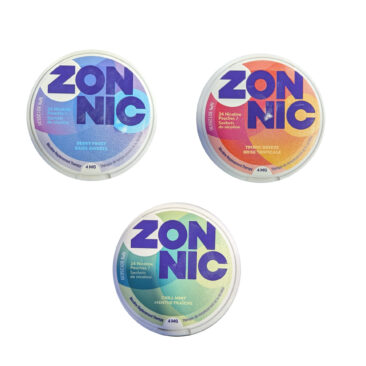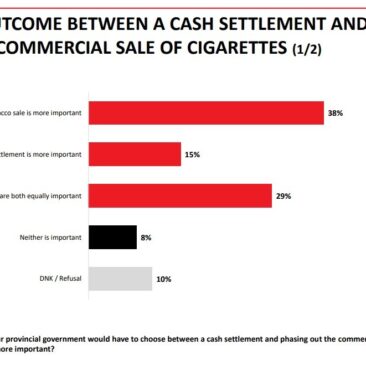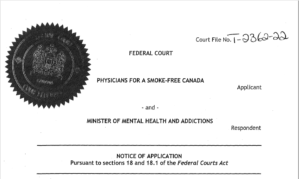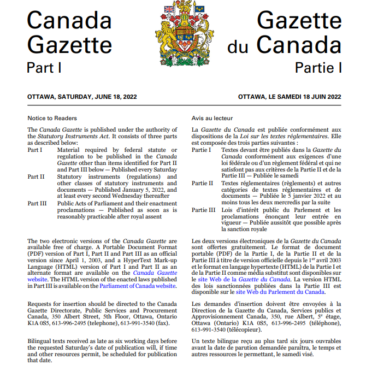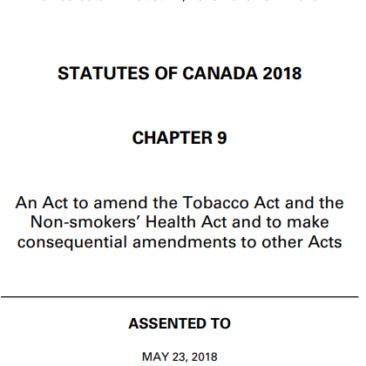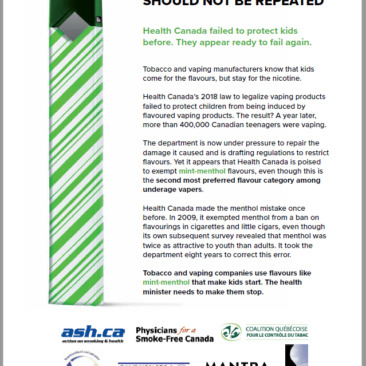Health Authorities have a tendency to use the first days of January and July as the moment when regulations come into force. And so it is that this week a number of changes to the tobacco and vaping regulations are taking effect. Links to more detailed fact sheets are at the bottom of this post.
Federal
Mandatory health 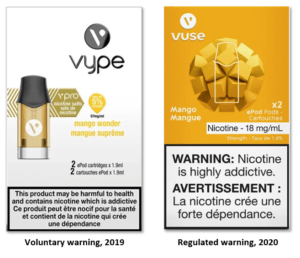 warnings and package requirements come into force. Last December, Health Canada published the final version of the Vaping Products Labelling and Packaging Regulations SOR/2019-353. These regulations were made under the authority of two federal laws — the Tobacco and Vaping Products Act and the Canadian Consumer Product Safety Act.
warnings and package requirements come into force. Last December, Health Canada published the final version of the Vaping Products Labelling and Packaging Regulations SOR/2019-353. These regulations were made under the authority of two federal laws — the Tobacco and Vaping Products Act and the Canadian Consumer Product Safety Act.
With these new regulations, vaping products are now required to carry warnings that cover 40% of the principal display panel and an even greater percentage on small packages. Only one warning on addiction is required, even though the companies had previously included voluntary warnings on general health effects.
The impact of the new regulation and package redesign are on BAT’s vaping brand is shown below.
These new warnings may not be immediately visible to Canadian consumers.Health Canada is reported to have agreed to the request of convenience stores to delay enforcement of the regulations until January 1, 2021.
Provincial
Ontario moves flavoured and high-nicotine vaping products out of convenience stores. In late February, the Ontario government announced that it would remove flavoured and high-nicotine vaping products from convenience stores and gas stations and permit their sale only in specialty vape shops. Ordinary stores would still be allowed to sell tobacco- and mint/menthol- flavoured vaping products, and vaping liquids that have less than 20 mg/ml concentratiaon of nicotine.
The original implementation date of May 1st, however, was delayed by two months to July 1st in response to concerns of convenience retailers that this would increase the risk of COVID transmission.
The Ontario government resisted pressure to further delay implementation of this new rule, but it too has agreed to give the industry a 6 month grace period before taking any enforcement actions. The Convenience Industry Council claimed that implementation required “a massive inventory change during the COVID crisis and the potential impacts on the health of our frontline workers”.
Nova Scotia requires e-cigarette vendors to be licensed. On Canada Day, Nova Scotia’s new requirements for retail and wholesale vendor permits for e-cigarettes comes into force. The three-year permits cost $124, and require permit holders to provide some business information that could be useful for public health monitoring.
Municipal
Edmonton’s ban on shisha bars comes into force. When amending its smoking bylaw last year, Edmonton City Council accepted a one-year delay before imposing restrictions on Hookah bars/Shisha lounges. These regulations will come into force this July 1st.
International
On July 1st, New York City ban on the sale of flavoured cigarettes comes into force. This city law was originally signed in December 2019. Because it was superseded by changes to New York State public health laws that were included in its 2020 budget which came into effect mid-May, the ban is already in effect. Other NY state changes which come into force on July 1st include a ban on on-line sales, ads near schools and reporting requirements for manufacturers and distributors. (See page 191 and later of the Budget Bill S7506B). So far in Canada, Quebec is the only jurisdiction to ban on-line sales. Health Canada intends to impose reporting requirements on vaping manufacturers,.
This week the Netherlands extends its ban on public smoking to e-cigarettes. Retail displays are also banned at supermarkets (the measure will affect other retailers, but not specialty tobacconists and kiosks at the end of the year).
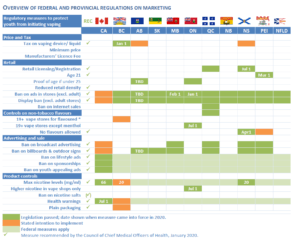 Summary fact sheets
Summary fact sheets
Two information products have been updated:
* Timeline of selected regulatory actions on electronic nicotine devices
* At-a-glance: Provincial restrictions on vaping products

